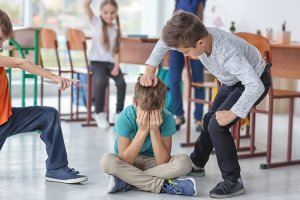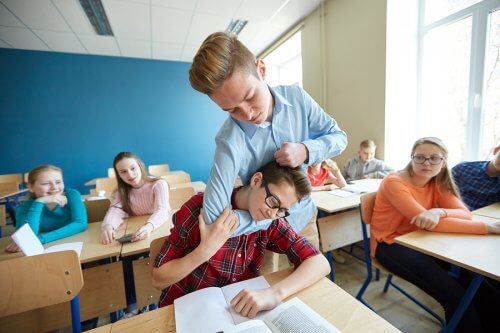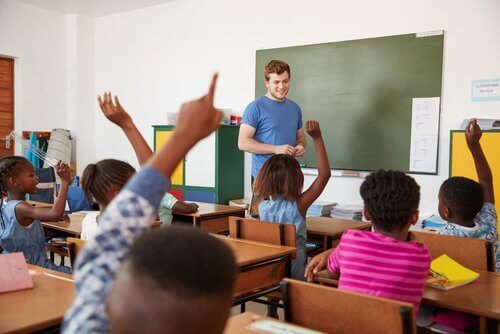How to Handle Conflict in the Classroom

The truth is that conflict in the classroom is a reality that we can’t escape from even today. Educational centers aren’t just learning spaces; they’re also where we interact with others on a daily basis. A school is a place where disagreements are bound to occur, and we have to address them in some way.
Even though they might be common disputes, it’s essential to arrive at a favorable resolution among students and teachers. In the following sections, we’ll go dig deeper into this issue to find possible solutions.
What are the conflicts?
First, it’s important to identify what a conflict is. Conflicts are situations in which two or more people don’t agree on something, and have different and incompatible opinions. Conflicts are common in everyday life.
In classrooms, this is how conflicts arise among teachers and students, as well as among the students themselves. Depending on the type of conflict and how it’s handled, it can directly affect the class’s progress and the learning process.
Keys to managing classroom conflict
While there is no secret formula for resolving these problems, since each person’s situation is different, there are some guidelines or keys for managing conflict in the classroom effectively.
In any situation, either between adults or between children, it’s important to involve the children in the resolution of the dispute so that they can learn about comprehensive attitudes and teamwork.

Preventing classroom conflict
First of all, it’s necessary to establish a good atmosphere in the classroom as well as a code of conduct. The adult in charge, i.e. the teacher, should dedicate time to the children who may be having problems, preferably individually.
Educators must also teach children good values and foster their emotional and social skills. Group activities are an excellent tool for doing this.
On the other hand, an excellent way to avoid conflict in the classroom is for each teacher to establish, along with the students, some basic rules of coexistence. Planning activities that develop and encourage dialogue and peace in the classroom are also helpful.
Promote communication
Communication, both verbal and nonverbal, mark human relationships within the classroom. Therefore, it’s vital to assign homework activities that have to do with developing communication skills among other fellow students, and among students and teachers.
However, it’s essential that the teachers work on their communication skills too, since the mood in the classroom depends on them.
Although we can’t always avoid conflicts from occurring, communication can be the critical tool for finding a solution. The resolution of conflictive situations through open dialogue and active listening are ways of acting that must be respected and instilled.
“Educators must teach children good values and foster their emotional and social skills”
Analysis of the nature, severity, and persistence of conflict in the classroom
The types of conflicts that occur at school can be social, cultural, curricular or relational; additionally, they may have different degrees of severity. To solve them, we must first identify the origin of the conflict, the participants and the interests that are at stake.

Always resort to mediation as a fundamental tool
On many occasions, the people involved in the conflict can’t solve it on their own. This is when mediation comes into play. It’s instrumental in conflicts between students in which the teacher functions as a mediator.
When there are problems among students in the classroom, the parent, teacher or any adult must help all parties involved to reach an agreement that favors everyone.
Mediation is a widely used and highly effective technique for managing conflict in the classroom. This technique is based mainly on communication, equality, and autonomy.
When the ones involved in the confrontation are also included in the mediation, the results are fairer and more equitable.
In conclusion, educational institutions and those who work in them must continuously encourage students to practice positive communication skills towards authorities and among themselves.
A classroom is a space of coexistence in which there is always going to be some conflict. It’s important to know how to manage disputes so that they don’t affect the group and the learning process.
The truth is that conflict in the classroom is a reality that we can’t escape from even today. Educational centers aren’t just learning spaces; they’re also where we interact with others on a daily basis. A school is a place where disagreements are bound to occur, and we have to address them in some way.
Even though they might be common disputes, it’s essential to arrive at a favorable resolution among students and teachers. In the following sections, we’ll go dig deeper into this issue to find possible solutions.
What are the conflicts?
First, it’s important to identify what a conflict is. Conflicts are situations in which two or more people don’t agree on something, and have different and incompatible opinions. Conflicts are common in everyday life.
In classrooms, this is how conflicts arise among teachers and students, as well as among the students themselves. Depending on the type of conflict and how it’s handled, it can directly affect the class’s progress and the learning process.
Keys to managing classroom conflict
While there is no secret formula for resolving these problems, since each person’s situation is different, there are some guidelines or keys for managing conflict in the classroom effectively.
In any situation, either between adults or between children, it’s important to involve the children in the resolution of the dispute so that they can learn about comprehensive attitudes and teamwork.

Preventing classroom conflict
First of all, it’s necessary to establish a good atmosphere in the classroom as well as a code of conduct. The adult in charge, i.e. the teacher, should dedicate time to the children who may be having problems, preferably individually.
Educators must also teach children good values and foster their emotional and social skills. Group activities are an excellent tool for doing this.
On the other hand, an excellent way to avoid conflict in the classroom is for each teacher to establish, along with the students, some basic rules of coexistence. Planning activities that develop and encourage dialogue and peace in the classroom are also helpful.
Promote communication
Communication, both verbal and nonverbal, mark human relationships within the classroom. Therefore, it’s vital to assign homework activities that have to do with developing communication skills among other fellow students, and among students and teachers.
However, it’s essential that the teachers work on their communication skills too, since the mood in the classroom depends on them.
Although we can’t always avoid conflicts from occurring, communication can be the critical tool for finding a solution. The resolution of conflictive situations through open dialogue and active listening are ways of acting that must be respected and instilled.
“Educators must teach children good values and foster their emotional and social skills”
Analysis of the nature, severity, and persistence of conflict in the classroom
The types of conflicts that occur at school can be social, cultural, curricular or relational; additionally, they may have different degrees of severity. To solve them, we must first identify the origin of the conflict, the participants and the interests that are at stake.

Always resort to mediation as a fundamental tool
On many occasions, the people involved in the conflict can’t solve it on their own. This is when mediation comes into play. It’s instrumental in conflicts between students in which the teacher functions as a mediator.
When there are problems among students in the classroom, the parent, teacher or any adult must help all parties involved to reach an agreement that favors everyone.
Mediation is a widely used and highly effective technique for managing conflict in the classroom. This technique is based mainly on communication, equality, and autonomy.
When the ones involved in the confrontation are also included in the mediation, the results are fairer and more equitable.
In conclusion, educational institutions and those who work in them must continuously encourage students to practice positive communication skills towards authorities and among themselves.
A classroom is a space of coexistence in which there is always going to be some conflict. It’s important to know how to manage disputes so that they don’t affect the group and the learning process.
All cited sources were thoroughly reviewed by our team to ensure their quality, reliability, currency, and validity. The bibliography of this article was considered reliable and of academic or scientific accuracy.
- Carreño, A. M. P. (2010). Conductas disruptivas en el aula. González Serrano, Fernando. https://archivos.csif.es/archivos/andalucia/ensenanza/revistas/csicsif/revista/pdf/Numero_34/ANA_MARIA_PORCEL_1.pdf
- Espot, M. R., & Nubiola, J. (2015). La disciplina en el aula. Vanguardia Educativa, 35-39. http://www.mariarosaespot.es/pdfs/pdf_articulo_la_disciplina_en_el_aula_ve_19va._edicion__copia__copia.pdf
- Pérez-de-Guzmán, V., Muñoz, L. V. A., & Vergara, M. V. (2011). Resolución de conflictos en las aulas: un análisis desde la Investigación-Acción. Pedagogía social: revista interuniversitaria, (18), 99-114. https://dialnet.unirioja.es/servlet/articulo?codigo=3430407
- Pérez, C. P. (2001). Estrategias para la solución de conflictos en el aula. Revista española de pedagogía, 143-156. https://www.jstor.org/stable/23765854?seq=1
This text is provided for informational purposes only and does not replace consultation with a professional. If in doubt, consult your specialist.








